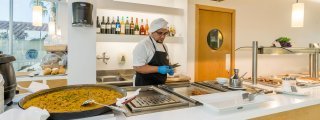Menorcan gastronomy

Menorcan gastronomy is born from the different inputs from the peoples and cultures that over the centuries have created a cuisine as full of contrasts and surprises as the very countryside in Menorca. Menorca brought mayonnaise to international cuisine and has adapted many elements from different countries to form a very personalised style. Both Islamic and Catalan cuisine from the middle ages and French inspiration have left the greatest mark on the recipes that have made Menorcan cuisine famous the world over.
Fish and seafood cookery have become the stars of Menorcan gastronomy, especially the famous lobster stew. On a base of onion, tomato, garlic and parsley the lobster is cut up and added and cooked on a high heat. The resulting soup is served with bread.
Delicious Menorcan dishes are: the grouper stew, grilled grouper with mayonnaise, baked sea bream, grilled squid, grilled or baked red mullet with potatoes, "escupinyas" (clams eaten raw with lemon or baked with a mixture of breadcrumbs, parsley and garlic), sea dates (cooked with sherry and parsley), "peus de cabrit" - goose barnacles (arca pelosa) and "cornets" (sea snails).
Other popular dishes are “arros de la terra” (rice of the land), a meat pasty and the “oliaigua”, akin to Mallorcan soups "sopas", vegetables and slices of dry bread cooked in stock which in summer is eaten with soft figs.

As far as sausage products are concerned, the typical "sobrasada" (a pork sausage-meat made with red pimiento) is made, finer and less spicy than that made in Mallorca, traditional sausage known as "carn i xua" made with lean meat, mixed with bacon cut into little cubes and seasoned with salt and pepper, always present on excursions or country outings and the "cuixot" which is black very greasy sausage similar to the Mallorcan "camaiot", a type of black pudding.
Menorcans love their deserts and the famous "amargos", made with almond, the “carquinyols” (almond and egg), “crespellets”, "ensaimadas", the typical circular pastries, the “rubiols”, Gypsy's arms - “braç de Gitano” and the toasted nougat known as “turró cremat” from Mercadal, as well as “coca bamba” (cake eaten with hot chocolate during the local fieatas) are all popular.
The long tradition of cattle farming on the island has led to a food industry using milk-based products. Cheeses in general and in particular the Mahón – Menorca cheese enjoys international repute.
The cheese is pressed from cow's milk from Friesian, Menorcan and Alpine cattle with the occasional addition of up to 5% Menorcan sheep's milk. The milk must be clean and full cream, with no preservatives and a balance between fat and protein characteristic of the races of cow mentioned and the milking season so the final product will be at least 38% fat as compared with the dry extract. It is known as semi-cured when it has been matured for fewer than 150 days and mature - "curado" if it is longer.
Vine growing and wine making cover 702 km2 and 216 km of coastline. Even though it is a small island, inhabitants and visitors alike can enjoy microcosms and exceptional environmental conditions with a valuable cultural heritage and good socio-economic development.



